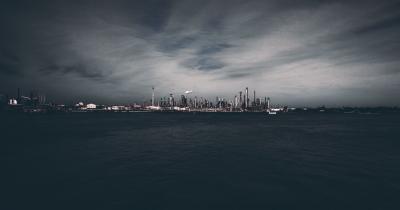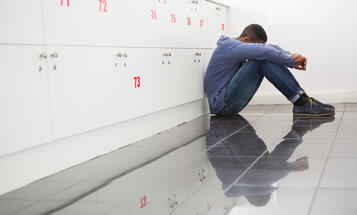
Fifty Years After Earth Day, Coronavirus, Climate Injustice, and Inequality Collide
The COVID-19 pandemic is an environmental justice crisis that's exposed inequalities that have persisted in places with decades of pollution.

On April 20, 10 years after the Deepwater Horizon oil rig exploded 40 miles off the Louisiana coast, the impacts of the second largest oil spill by volume in history linger. Every fish in the Gulf of Mexico today has some trace of oil in it. While coastal communities have worked with scientists and policymakers to restore the Gulf ecosystem, the Gulf Coast region still contends with pollution and oil industry expansion, especially as Trump has pursued extension of off-shore oil and gas leasing while gutting safety protections.
Today the people of the Gulf South reel from another crisis. Louisiana has become one of the nation’s hotspots of coronavirus, with nearly 24,000 confirmed COVID-19 infections and almost 1,300 who have died from the virus. Cancer Alley residents, long exposed to toxic pollution from the region’s petrochemical industry, now have some of the highest coronavirus rates in the country.
These dual crises are linked.
These dual crises are linked. As the coronavirus curve potentially extends into the summer, we may see the aggravation of threats from climate disasters like hurricanes, heat waves, and wildfires across the country. How does one socially distance when forced to evacuate?
In the face of public health, economic, and climate crises, this moment echoes the awakening of the modern environmental movement 50 years ago, when the first Earth Day took place. Americans came face-to-face with the unignorable ecological and health consequences of unregulated polluting industries, made apparent by events like a massive oil spill off the Santa Barbara, California coast and by intense environmental activism. Environmental organizers launched the first Earth Day as a mass action, with over 20 million people participating in teach-ins and actions across the country.
Our current conditions are as unique as the novel coronavirus, but the unfolding crises echo the public health, economic, and environmental emergencies that brought about that first Earth Day.
Today, on the 50th anniversary of the first Earth Day, people everywhere are organizing remotely to participate in online teach-ins and digital demonstrations. Our current conditions are as unique as the novel coronavirus, but the unfolding crises echo the public health, economic, and environmental emergencies that together brought about that first Earth Day.
Coronavirus is an environmental justice crisis. The response governments have taken has exposed inequalities that have persisted in places from Cancer Alley to the Bronx and Queens, where people have lived with decades of pollution. As millions have lost jobs, low-income frontline workers continue to keep society running, while exposing themselves to risk. Data are emerging that Black people across the country are disproportionately contracting and dying from coronavirus, and Native American communities are also being hit dramatically.
On April 17, the CDC released new racial data showing that 30 percent of patients whose race was identified were Black. The AP has conducted its own analysis that shows nearly one-third of deaths from COVID-19 in the U.S. are of Black Americans. State data reveal Black people in Michigan are 33 percent of its coronavirus cases and 40 percent of its deaths, despite being only 14 percent of the population. Black people in Wisconsin, who are 6 percent of the state’s population, are 24 percent of coronavirus cases and 34 percent of deaths. In New York City, the virus appears to be killing Black and Latino people at twice the rate of white New Yorkers.
The fact that St. John the Baptist Parish in Cancer Alley hosts the highest COVID-19 death rate in the country per capita is no accident.
The fact that St. John the Baptist Parish in Cancer Alley hosts the highest COVID-19 death rate in the country per capita is no accident. The same Black and brown populations who live with air pollution and impacts of fossil fuel extraction are now some of the communities most at risk to the virus. Respiratory conditions like asthma and lung disease increase vulnerability to infection; remarkable new studies show that air pollution like PM 2.5 particulate matter and NO2 pollutants have strong correlation with higher fatality rates due to COVID-19. Living in proximity to pollution is likely to increase risk of death due to coronavirus.
The coronavirus is a crisis of environmental inequality. Effectively resolving the crisis will require confronting the environmental racism that has resulted in uneven public health outcomes for decades.
Fifty years after the original Earth Day, we face the entwined crises of coronavirus, climate injustice, and inequality. There is no mitigating the risk of illness and mortality without addressing health disparities rooted in unequal environmental and social burdens.
Social policies that address inequality must be part of our path to flattening the coronavirus curve.
Policies like ending utility shut-offs and evictions, and expanding social programs, which advocates have pushed to include in recent government stimulus plans, can help improve the quality of life for vulnerable communities in the midst of this emergency. A long-term economic recovery can build green infrastructure and improve access to public goods and services, in ways that result in measurable health benefits. Social policies that address inequality must be part of our path to flattening the coronavirus curve.
This pandemic must also be tackled in tandem with ending fossil fuel pollution that impacts Black and brown communities most. Investing in climate solutions that end fossil fuel extraction and pollution, and strengthen resilience to climate change in the most vulnerable communities, as proposed in the Green New Deal and climate legislation like New York’s Climate Leadership and Community Protection Act, will reduce climate change and pollution risk as well as help us prepare for future crises.
Most of all, we must design our response to crises, including public health crises, to support communities most vulnerable, and to tear down the structural inequalities that create Cancer Alleys, putting an end to the decades-long violence on Black and brown communities culminating in pollution and pandemic.




